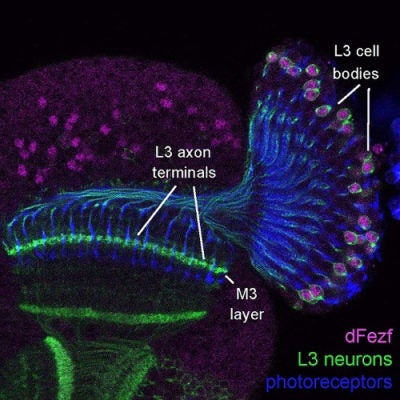By Jing Peng and Ivan Santiago
This community story is a special piece honoring the memory of our mentor Matt Pecot, who sadly passed away in 2019. This work was carried out in his lab. Please scroll to the bottom of this scientific update to read our words of remembrance about Matt. You can also click here to view a special edition of the Neuro Dept newsletter, The Action Potential, dedicated to Matt.
Precise organization of complex neural circuits underlies an organism’s ability to properly sense, adapt, and respond to its environment. Compartmentalization of correct synaptic partners into discrete layers is thought to facilitate the establishment of proper connectivity during development. Despite the prominence of layers across brain regions, including the cerebral cortex and spinal cord, as well as its conservation across species, the mechanisms underlying layer assembly of neural connections are not well understood.
Studies in several model organisms suggest that layer assembly is a dynamic process beginning with the innervation of broad primordial regions by neurites, and the subsequent emergence of layered circuits from those broad domains. Currently, it is unclear how these distinct steps are accomplished and coordinated.

Fluorescently labeled L3 lamina neurons in the fly visual system. L3 neurons are labeled in green, photoreceptors in blue, and dFezf transcription factor in magenta.
To shed light on this question we leveraged the genetic tractability of the Drosophila melanogaster visual system. In the fly eye, L1-L5 lamina neurons innervate distinct layers throughout the medulla neuropil (M1-M5) wherein they form stereotyped connections with other neuron types. Layer-specific innervation is preceded by the targeting of L1-L5 growth cones in one of two broad, primordial domains (distal and proximal) from which the M1-M5 layers will emerge. Thus, lamina neurons first innervate the developing neuropil in an overlapping manner before segregating into their developing incipient layers.
Previously, we showed that the transcription factor dFezf is uniquely expressed in L3 neurons, where it cell-autonomously directs L3 growth cones to the proximal domain and ultimately the M3 layer. In our recent study, we used RNA sequencing and mutant mosaic analysis to uncover the causal downstream dFezf target. We found that genes encoding cell surface proteins and transcription factors are two of the largest groups of differentially expressed genes in dFezf-null L3 neurons. We discovered that the transcription factor sloppy-paired 1 (slp1), which is significantly upregulated when dFezf is knocked out, is responsible for the mistargeting phenotype observed in dFezf-null L3 neurons. Unexpectedly, we also found that low expression levels of slp1 observed in wild type L3 neurons is required for segregation into the incipient layer from the broad domain, indicating that an intricate balance of transcription factor levels throughout development underlie the stepwise emergence of layered circuitry, likely through the regulation of the robust repertoire of cell surface molecules.
Organization of synaptic connectivity into layers is a common feature of the nervous system across species. Our work revealed a temporally precise transcriptional cascade that orchestrated the assembly of synaptic layers in the fly visual system. Interestingly, the vertebrate ortholog of dFezf, FEZF1, was recently shown to direct layer-specific innervation in the mouse retina. It will be intriguing to assess whether Fezf orthologs regulate layer assembly through conserved transcriptional cascades.
Jing Peng is a postdoctoral fellow in the Neurobiology Department at HMS.
Ivan Santiago is a recent graduate of the PhD Program in Neuroscience at Harvard, now a postdoc at Columbia University. Both were members of Matt Pecot’s lab.
Learn more in the original article:
Drosophila Fezf functions as a transcriptional repressor to direct layer-specific synaptic connectivity in the fly visual system
Ivan J. Santiago, Dawei Zhang, Arunesh Saras, Nicholas Pontillo, Chundi Xu, Xiaoting Chen, Matthew T. Weirauch, Meeta Mistry, David D. Ginty, Matthew Y. Pecot, and Jing Peng. PNAS March 30, 2021 118 (13) e2025530118; https://doi.org/10.1073/pnas.2025530118
Our remembrances of Matt Pecot, a brilliant scientist and extraordinary mentor:
I had the honor of being a founding member of the Pecot Lab. This journey – from borrowing pipettes from the Kaeser Lab, to publishing our first paper, and ultimately to saying goodbye to Matt – has been the most profound learning experience of my life. Perhaps the greatest lesson I learned from my mentor is that there should always be space for compassion in science. During our final year together as he battled cancer, I was going through my own battle in grieving the loss of my mother. When I disappeared from the lab for a long time, Matt reached out to me to make sure I was okay and to assure me that I had his support. After I returned, although I struggled immensely with writing my dissertation, I never gave up because I saw my mentor fighting his hardest to be there for us. I am thankful to Matt for his patience, passion, and all the lessons he taught me. My experience as Matt’s mentee will continue to empower me in my rigorous pursuit of knowledge, and my passionate pursuit of a life well lived.
–Ivan Santiago
In the Pecot lab, we learned that science is fun and yet challenging. The two things about Matt that touched me the most were his enthusiasm and persistence. During the two years of screening following our eLife paper, which resulted mostly in negative data, Matt was always there, fighting with us. Together as a team, our hard work paid off and we finally identified slp1 as a dFezf target. A few days before Matt passed way, his wife Yi relayed to him the message about the discovery. He was excited and immediately tried to come up with more ideas. That was Matt, always excited about science. He will always be remembered dearly as a great scientist and a wonderful mentor.
–Jing Peng

News Types: Community Stories
